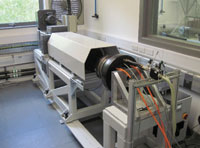
Posted to News on 8th Aug 2012, 00:00
Developing the Protean Drive for electric vehicles
The integrated motor and inverter in the Protean Drive provides all the high power and torque needed for the electrification of vehicles without compromising vehicle performance or cost. It also enables full regenerative braking in normal driving to recapture large amounts of kinetic energy that is subsequently fed back into the batter. And all of this is packaged in-wheel, which saves huge amounts of space in the vehicle for passengers and batteries, and eliminates all external transmission components. In addition, it provides advanced vehicle dynamics through the independent torque control of each wheel.

>Developing the drive system required a great deal of careful testing and characterising to cover every performance aspect, and having proved the concept, Protean Electric is now continuing to increase the efficiency of the in-wheel electric motor and regenerative braking capability to further improve performance.
>Characterisation is performed on in-house dynamometers and involves the interaction of a number of different systems for control and data acquisition. Both the Protean Drive system and the dynamometers are separately controlled via CAN, and during testing a large amount of data is collected from a wide variety of inputs including multiple CAN channels, temperatures, pressures, volt-ages, currents and digital inputs. The aim was to automate this testing to help reduce the time Protean's engineers spend performing characterisation work.
>Protean's solution was to use the integrated hardware and software offered by National Instruments to dramatically reduce both time and costs through automation. Protean's product validation manager Mark McDonnell says: "LabVIEW was an obvious choice due to its widespread use in the industry and the large range of compatible hardware available both directly from National Instruments and offered by third-party manufacturers."
>Protean used LabVIEW to create a fully automated control program capable of independently controlling both the Protean Drive system and the dynamometer via CAN, as well as providing integrated fault monitoring and data logging. "The automated, integrated system we created using LabVIEW software and NI CompactDAQ hardware revolutionised our product testing," says McDonnell. "Testing that used to require up to three weeks can now be completed in just 12 hours, completely unmanned and automated. This has literally saved us months of engineers' time."









